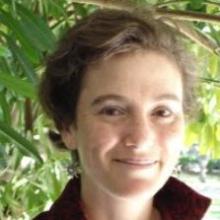
Julia Dallman, Ph.D.
Associate Professor
Department of Biology
University of Miami
Thriving in the face of life’s curve balls
Life is good at throwing curve balls, as I learned when I was a postdoctoral researcher in Dr. Gail Mandel’s (currently at OSHU’s Vollum Institute) lab at Stony Brook University. In one weekend, I found out that I was diagnosed with Hodgkin Lymphoma, the daycare provider for my then two-year-old son would be closing, and my family would either have to buy or move out of the house we were renting.
That terrible weekend is 13 years behind me now, and I am happy to say that, not only am I alive and no longer a postdoc, but, incredibly enough, my family is thriving and I am directing my own lab at the University of Miami as a tenured associate professor. Getting from those awful two days to my current position was only possible with the unwavering support of my many mentors, my community, my husband Dr. James Baker (also a scientist), and the NINDS K01 Career Award that helped secure my place on the tenure track.
Before my lymphoma diagnosis, I was studying REST (Repressor Element 1 Silencing Transcription factor), which in vertebrates is critical for shutting off the neuronal phenotype in non-neuronal tissue and was thought to be conserved across species, as many other “master regulators” are. Surprisingly, my work showed that flies use the transcription factor Tramtrack instead.
Although the science in Dr. Mandel’s lab proved a wonderful distraction during and after cancer treatment, full recovery took several years. During this time, my productivity suffered. In hindsight, I realize that there are many routes to success, but at the time I felt I had “fallen behind” and couldn’t see a clear path to stay in science after so much time had passed.
Luckily, Dr. Paul Brehm, who worked across the hall, encouraged me to reconsider. He introduced me to the re-entry Career Development K01 Award1 from NINDS and served as the mentor for the award. The application was centered on marrying my physiology background with the molecular biology techniques I had learned in my first postdoc. My ultimate goal was to establish a line of inquiry that would be productive and interesting over the long-term and with which I could launch my scientific career.
One particular mutant zebrafish strain in Dr. Brehm’s lab piqued my interest: as embryos, they are paralytic but they naturally recover the ability to move as they develop—a condition with parallels to my own recovery. The research we proposed on the motor circuit of the glial glycine transporter GlyT1 zebrafish mutant expanded my physiology expertise from single-cell to circuits while I simultaneously conducted a genetic screen in the lab to identify other promising mutants for future study in my own lab that I could take with me to launch my independent research.
Additionally, writing the K01 was a revelation. Dr. Brehm taught me how the entire application should make an argument for why the research should be funded. For example, the background section shouldn’t be a list of known facts, but a narrative that draws the reader along and leads them to the conclusion that this research is exciting and necessary. That lesson has been very influential in my grant writing to this day.
After the research was completed, armed with a collection of interesting projects and a grant, I went on the job market and had the privilege to interview at several universities. I landed a job at the University of Miami, where my husband also secured a faculty position. My focus shifted to forging productive collaborations to build my publication record, which will always show a gap from the time of my illness. Like many in my situation, I struggled with how or whether to discuss the reason for this gap in grant applications—I didn’t want it to sound like an excuse. Despite these concerns, I have successfully competed for NIH and foundation funding and was recently awarded tenure at University of Miami. I owe my present and future to both scientific and non-scientific mentors who supported me through my illness and beyond, and I am eternally grateful to them.
- As told to Lauren Ullrich.
1The NINDS Faculty Development Award (K01) no longer supports re-entry; instead consider applying for a Research Supplement to Promote Re-Entry
Current Research
My current research program aims to improve our understanding of inherited nervous system disorders by modeling them in zebrafish.
We now know the identity of thousands of human genetic mutations linked to nervous system disorders due to the concerted efforts from large consortia of medical doctors and human geneticists sequencing patient genomes. Contrary to expectation—that common diseases would be explained by common mutations—we have learned that for any given disease there are often hundreds of rare, disparate types of mutations producing similar sets of symptoms. By comparing multiple genetic forms of a single disorder, we hope to determine how different types of mutations converge on similar manifestations of the same disease. Our rationale is that an understanding of underlying causes is a critical first step in development of more effective treatment strategies for individuals with inherited nervous system disorders.
